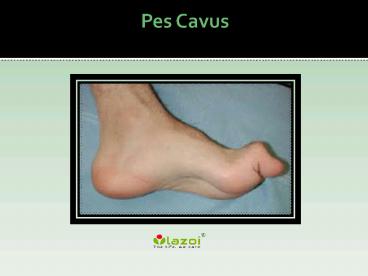Pes Cavus: Causes, Symptoms, Daignosis, Prevention and Treatment - PowerPoint PPT Presentation
Title:
Pes Cavus: Causes, Symptoms, Daignosis, Prevention and Treatment
Description:
Pes Cavus is an abnormally high arched foot. – PowerPoint PPT presentation
Number of Views:234
Title: Pes Cavus: Causes, Symptoms, Daignosis, Prevention and Treatment
1
Pes Cavus
2
Pes Cavus
- Pes cavus is an abnormally high arched foot.
People with this condition place too much weight
and stress on the ball and heel of the foot at
the time of standing or walking.
3
Causes of Pes Cavus
- Pes cavus can be caused by an underlying
disease, injury, or an inherited foot problem.
Causes of pes cavus include - Polio
- Spinal cord tumor
- Charcot-Marie-Tooth disease
- Muscular dystrophy
- Cerebral palsy
- Friedreich ataxia
- Clubfoot
- Compartment syndrome
- Crush injury
- Structural abnormality
- Inherited condition
4
Risk Factors related with Pes Cavus
- Pes cavus has a tendency to run in families. If
you are having a family member who is living with
very high arches, then you may be at increased
risk for developing pes cavus.
5
Diagnosis of Pes Cavus
- The doctor will ask you about your symptoms and
medical history. A physical exam will be done.
You will also be asked about your family medical
history. Your foot will be checked closely. Your
doctor may move your foot around to assess range
of motion.You can also be referred to a
specialist. An orthopedist specializes in bones.
Podiatrists specialize in feet. The condition can
be caused by a nervous system condition. In this
case your doctor may refer you to a
neurologist.Images may need to be taken of your
foot. This can be done with x-rays.
6
Prevention
- There are no known guidelines to prevent pes
cavus from developing.
7
Symptoms of Pes Cavus
- Symptoms associated with pes cavus include
- Foot pain
- Stiff joints
- Pain when standing or walking
- Hammertoes
- Claw toes
- Calluses
- Foot dropthe foot does not flex up
- Instability
8
Treatment for Pes Cavus
- Talk with your doctor about the best plan for
you. Options include the followingSupportive
DevicesChanges may need to be made to provide
foot support - Orthotic devices are custom-made inserts which
are placed into shoes that provide support,
stability, and cushioning. - Soft-soled shoes, wider shoes, and high-topped
shoes can help in managing symptoms. - Braces may be recommended to position the foot or
to treat foot drop, which can interfere with
normal walking. - Pads may be recommended to cushion your feet to
prevent corns and calluses from developing.
9
Treatment for Pes Cavus
Continue
- SurgeryIn some of the instances, medical
treatment is not effective, so surgery is
considered. The type of surgery depends on what
is causing the pes cavus. One type of surgery,
called an osteotomy extracts part of the bone to
correct the problem.For some instances, medical
treatment is not very effective, so surgery is
considered. The type of surgery basically depends
on what is causing the pes cavus. One type of
surgery, called an osteotomy removes part of the
bone to correct the deformity.
10
CONNECT WITH US
- Logon to
- www.lazoi.com
- Like us on Facebook
- https//www.facebook.com/LazoiTheLife
- Follow us on Twitter
- https//www.twitter.com/lazoithelife
- Follow us on Pinterest
- https//www.in.pinterest.com/lazoithelife































